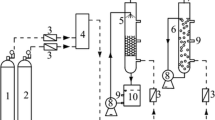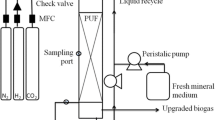Abstract
The oxidation of methane (CH4) using biofilters has been proposed as an alternative to mitigate anthropogenic greenhouse gas emissions with a low concentration of CH4 that cannot be used as a source of energy. However, conventional biofilters utilize organic packing materials that have a short lifespan, clogging problems, and are commonly inoculated with non-specific microorganisms leading to unpredictable CH4 elimination capacities (EC) and removal efficiencies (RE). The main objective of this work was to characterize the oxidation of CH4 in two biotrickling filters (BTFs) packed with polyethylene rings and inoculated with two methanotrophic bacteria, Methylomicrobium album and Methylocystis sp., in order to determine EC and CO2 production (pCO2) when using a specific inoculum. The repeatability of the results in both BTFs was determined when they operated at the same inlet load of CH4. A dynamic mathematical model that describes the CH4 abatement in the BTFs was developed and validated using mass transfer and kinetic parameters estimated independently. The results showed that EC and pCO2 of the BTFs are not identical but very similar for all the conditions tested. The use of specific inoculum has shown a faster startup and higher EC per unit area (0.019 gCH4 m−2 h−1) in comparison to most of the previous studies at the same CH4 load rate (23.2 gCH4 m−3 h−1). Global mass balance showed that the maximum reduction of CO2 equivalents was 98.5 gCO2eq m−3 h−1. The developed model satisfactorily described CH4 abatement in BTFs for a wide range of conditions.








Similar content being viewed by others
References
Avalos Ramírez A, García Aguilar B, Jones P, Heitz M (2012) Improvement of methane biofiltration by the addition of non-ionic surfactants to biofilters packed with inert materials. Process Biochem 47:76–82
Boiesen A, Arvin E, Broholm K (1993) Effect of mineral nutrients on the kinetics of methane utilization by methanotrophs. Biodegradation 4(3):163–170
Delhoménie MC, Nikiema J, Bibeau L, Heitz M (2008) A new method to determine the microbial kinetic parameters in biological air filters. Chem Eng Sci 63(16):4126–4134
Dorado AD, Baeza JA, Lafuente J, Gabriel D, Gamisans X (2012) Biomass accumulation in a biofilter treating toluene at high loads—part 2: model development, calibration and validation. Chem Eng J 209:670–676
Estrada JM, Lebrero R, Quijano G, Pérez R, Figueroa-González I, García-Encina PA, Muñoz R (2014) Methane abatement in a gas-recycling biotrickling filter: evaluating innovative operational strategies to overcome mass transfer limitations. Chem Eng J 253:385–393
Girard M, Avalos Ramirez A, Buelna G, Heitz M (2011) Biofiltration of methane at low concentrations representative of the piggery industry—influence of the methane and nitrogen concentrations. Chem Eng J 168:151–158
Hanson R, Hanson T (1996) Methanotrophic bacteria. Microbiol Rev 60(2):439–471
Haubrich R, Widmann R (2006) Evaluation of aerated biofilters systems for microbial methane of poor landfill gas. Waste Managment 26: 408-416
Havran V, Dudukovic M, Lo C (2011) Conversion of methane and carbon dioxide to higher value products. Ind Eng Chem Res 50:7089–7100
Huq MN, Ralph BJ, Rickard PAD (1978) The extracellular polysaccharide of a methylotrophic culture. Aust J Biol Sci 31:311–316
Jimenez L, Arrieaga S, Aizpuru A (2016) Assessing biofiltration repeatability: statistical comparison of two identical toluene removal systems. Environ Technol 37(6). doi:10.1080/09593330.2015.1077894
López JC, Quijano G, Souza TS, Estrada JM, Lebrero R, Muñoz R (2013) Biotechnologies for greenhouse gases (CH4, N2O and CO2) abatement: state of the art and challenges. Appl Microbiol Biotechnol 97:2277–2303
Ménard C, Ramirez AA, Heitz M (2014) Kinetics of simultaneous methane and toluene biofiltration in an inert packed bed. J Chem Technol Biotechnol 89(4):597–602
Mrazovac SM, Milan PR, Vojinovic-Miloradov MB, Tosic BS (2012) Dynamic model of methane–water diffusion. Appl Math Model 36(9):3985–3991
Nikiema J, Heitz M (2010) The use of inorganic packing materials during methane biofiltration. Int J Chem Eng 2010. Article ID 573149:8
Nikiema J, Girard M, Brzezinski R, Heitz M (2009a) Biofiltration of methane using an inorganic filter bed: influence of inlet load and nitrogen concentration. Can J Civ Eng 36(12):1903–1910
Nikiema J, Payre G, Heitz M (2009b) A mathematical steady state model for methane bioelimination in a closed biofilter. Chem Eng J 150(2–3):418–425
Ordaz A, López JC, Figueroa-González I, Muñoz R, Quijano G (2014) Assessment of methane biodegradation kinetics in two-phase partitioning bioreactors by pulse respirometry. Water Res 67:46–54
Perdikea K, Mehrotra AK, Hettiaratchi JP (2008) Study of thin biocovers (TBC) for oxidizing uncaptured methane emissions in biorreactor landfills. Waste Manag 28:1364–1274
Pfluger A, Wu WM, Pieja AJ, Wan J, Rostkowski K, Criddle C (2011) Selection of type I and type II methanotrophic proteobacteria in a fluidized bed reactor under non-sterile conditions. Bioresour Technol 102:9919–9926
Plessis C (2003) Empirical model for methane oxidation using a composted pine bark biofilter. Fuel 82(11):1359–1365
Rocha Ríos J, Bordel S, Hernández S, Revah S (2009) Methane degradation in two-phase partition bioreactors. Chem Eng J 152:289–292
Rodrigues A, Valdman B, Salgado AM (2009) Analysis of methane biodegradation by Methylosinus trichosporium OB3b. Braz J Microbiol 40(2):301–307
Sadasivam BY, Reddy KR (2014) Landfill methane oxidation in soil and bio-based cover systems: a review. Rev Environ Sci Biotechnol 13:79–107
Scheutz C, Bogner J, De Visscher A, Gebert J, Hilger H, Huber-Humer M, Kjeldsen P, Spokas K (2009) Microbial methane oxidation processes and technologies for mitigation of landfill gas emissions. Waste Manag Res 27:409–455. doi:10.1177/0734242X09339325
Sohngen NL (1906) Uber bakterien welche methan ab kohlenstoffnahrung und energiequelle gerbrauchen (on bacteria which use methane as a carbon and energy source). Z Bakteriol Parazitenk (Infektionster) 15:513–517
Veillete M, Viens P, Avalos Ramirez A, Brzezinski R, Heitz M (2011) Effect of ammonium concentration on microbial population and performance of a biofilter treating air polluted with methane. Chem Eng J 171:1114–1123
Veillete M, Girard M, Viens P, Brzezinski R, Heitz M (2012) Function and limits of biofilters for the removal of methane in exhaust gases from the pig industry. Appl Microbiol Biotechnol 94(3):601–6011
Acknowledgments
This research was financed by the National Fund for Science and Technology (FONDECYT), Project 1110919, and the Pontificia Universidad Católica de Valparaíso. We thank the Biofilm and Environmental Microbiology Laboratory of the Universidad de Concepción who helped us to acquire SEM pictures.
Author information
Authors and Affiliations
Corresponding author
Additional information
Responsible editor: Gerald Thouand
Rights and permissions
About this article
Cite this article
Cáceres, M., Dorado, A.D., Gentina, J.C. et al. Oxidation of methane in biotrickling filters inoculated with methanotrophic bacteria. Environ Sci Pollut Res 24, 25702–25712 (2017). https://doi.org/10.1007/s11356-016-7133-z
Received:
Accepted:
Published:
Issue Date:
DOI: https://doi.org/10.1007/s11356-016-7133-z




